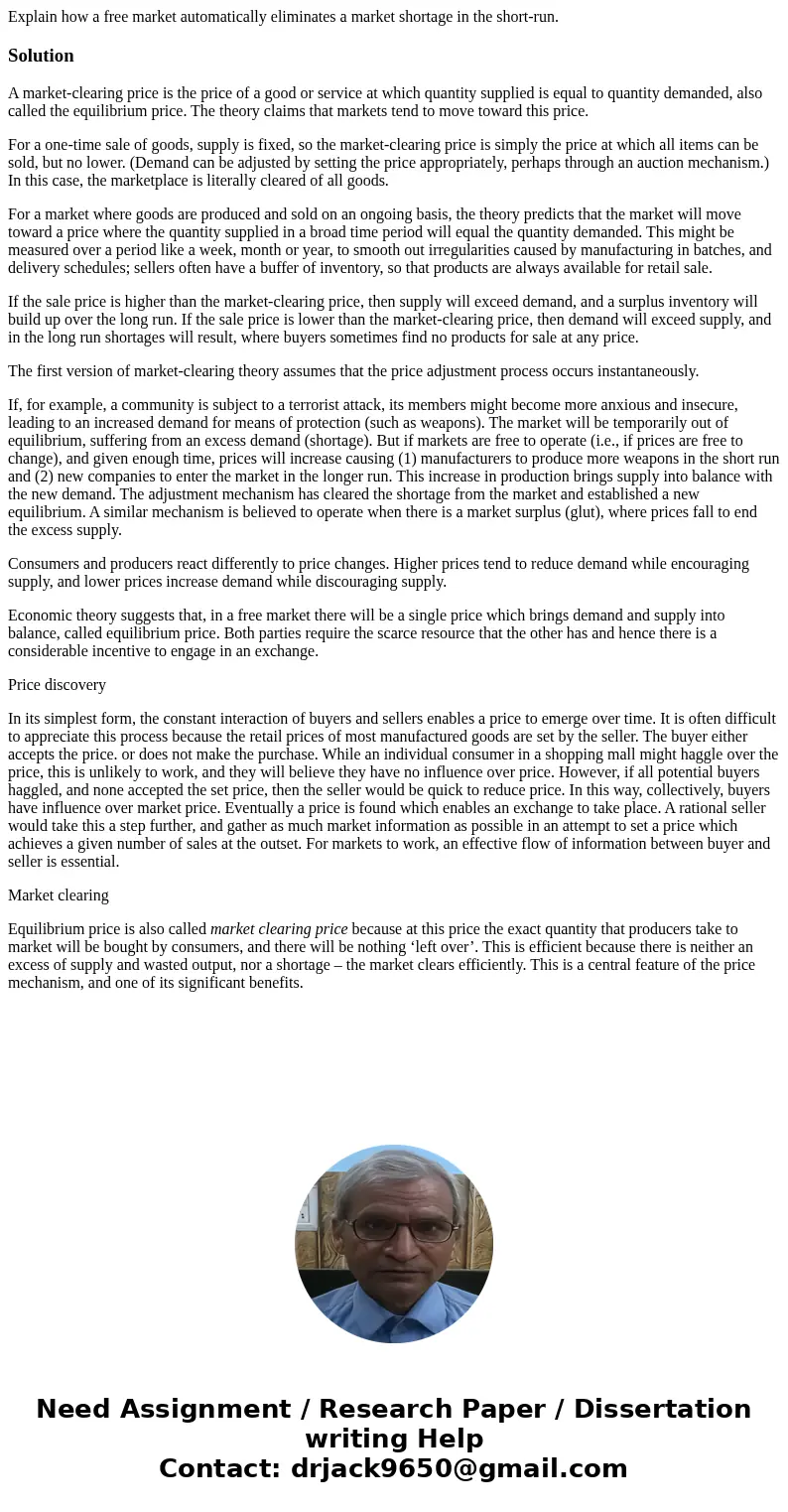Explain how a free market automatically eliminates a market
Explain how a free market automatically eliminates a market shortage in the short-run.
Solution
A market-clearing price is the price of a good or service at which quantity supplied is equal to quantity demanded, also called the equilibrium price. The theory claims that markets tend to move toward this price.
For a one-time sale of goods, supply is fixed, so the market-clearing price is simply the price at which all items can be sold, but no lower. (Demand can be adjusted by setting the price appropriately, perhaps through an auction mechanism.) In this case, the marketplace is literally cleared of all goods.
For a market where goods are produced and sold on an ongoing basis, the theory predicts that the market will move toward a price where the quantity supplied in a broad time period will equal the quantity demanded. This might be measured over a period like a week, month or year, to smooth out irregularities caused by manufacturing in batches, and delivery schedules; sellers often have a buffer of inventory, so that products are always available for retail sale.
If the sale price is higher than the market-clearing price, then supply will exceed demand, and a surplus inventory will build up over the long run. If the sale price is lower than the market-clearing price, then demand will exceed supply, and in the long run shortages will result, where buyers sometimes find no products for sale at any price.
The first version of market-clearing theory assumes that the price adjustment process occurs instantaneously.
If, for example, a community is subject to a terrorist attack, its members might become more anxious and insecure, leading to an increased demand for means of protection (such as weapons). The market will be temporarily out of equilibrium, suffering from an excess demand (shortage). But if markets are free to operate (i.e., if prices are free to change), and given enough time, prices will increase causing (1) manufacturers to produce more weapons in the short run and (2) new companies to enter the market in the longer run. This increase in production brings supply into balance with the new demand. The adjustment mechanism has cleared the shortage from the market and established a new equilibrium. A similar mechanism is believed to operate when there is a market surplus (glut), where prices fall to end the excess supply.
Consumers and producers react differently to price changes. Higher prices tend to reduce demand while encouraging supply, and lower prices increase demand while discouraging supply.
Economic theory suggests that, in a free market there will be a single price which brings demand and supply into balance, called equilibrium price. Both parties require the scarce resource that the other has and hence there is a considerable incentive to engage in an exchange.
Price discovery
In its simplest form, the constant interaction of buyers and sellers enables a price to emerge over time. It is often difficult to appreciate this process because the retail prices of most manufactured goods are set by the seller. The buyer either accepts the price. or does not make the purchase. While an individual consumer in a shopping mall might haggle over the price, this is unlikely to work, and they will believe they have no influence over price. However, if all potential buyers haggled, and none accepted the set price, then the seller would be quick to reduce price. In this way, collectively, buyers have influence over market price. Eventually a price is found which enables an exchange to take place. A rational seller would take this a step further, and gather as much market information as possible in an attempt to set a price which achieves a given number of sales at the outset. For markets to work, an effective flow of information between buyer and seller is essential.
Market clearing
Equilibrium price is also called market clearing price because at this price the exact quantity that producers take to market will be bought by consumers, and there will be nothing ‘left over’. This is efficient because there is neither an excess of supply and wasted output, nor a shortage – the market clears efficiently. This is a central feature of the price mechanism, and one of its significant benefits.

 Homework Sourse
Homework Sourse